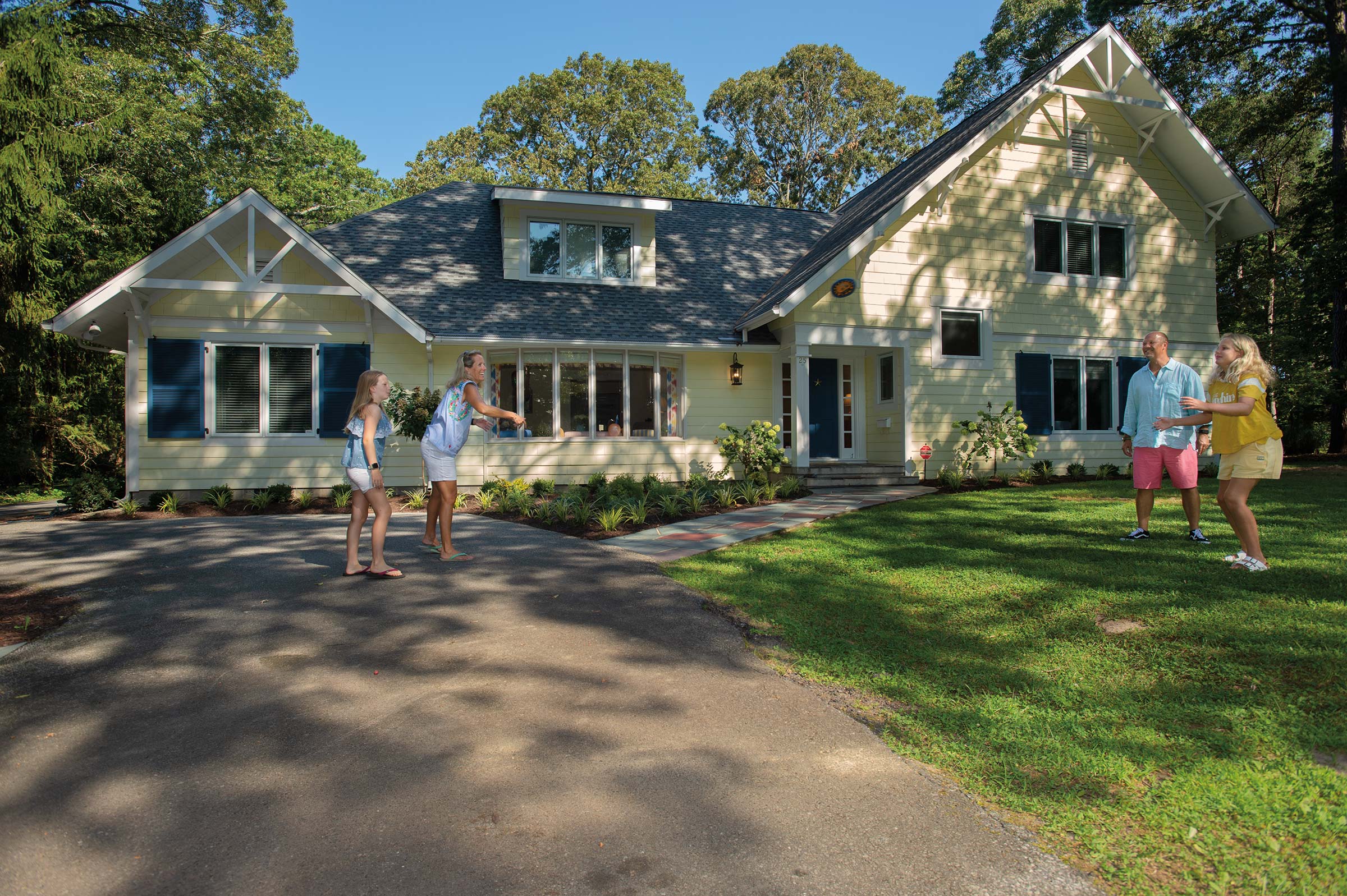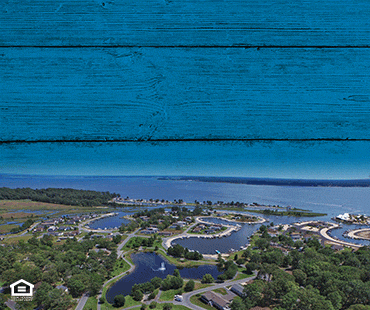
COVID-19 jolted the coastal home sales market in more ways than one. First, it put the skids on a 2020 uptick; then it inspired housebound potential buyers to make a move.
By Larry Nagengast | Photographs by This email address is being protected from spambots. You need JavaScript enabled to view it.
From the October 2020 issue

A promising start.
A screeching halt.
An unexpected and strong resurgence.
2020 has been a year of shocks and surprises — and there are still three months to go — but one of its most pleasant developments in coastal Sussex has been the sudden rebound of the residential real estate and construction markets in late spring and summer.
Since Gov. John Carney declared a state of emergency on March 13, shutting down many business activities throughout the state, the region’s hospitality industry and the beach retail sector have struggled. But the home market barely skipped a beat.
“When the pandemic hit, we were paralyzed — shut down for a couple of weeks,” says Debbie Reed, head of the Rehoboth-based Debbie Reed Team, a ReMax affiliate.
The paralysis was only temporary.
“In May, who would have thought that the pandemic would boost the local real estate market?” wonders Shaun Tull of Jack Lingo Realtor in Rehoboth.
“It became a feeding frenzy, a seller’s market,” says Liz Myers Barnhardt, a Realtor with Ocean Atlantic Sotheby’s International Realty near Midway. “Buyers are moving quicker. If they see a house they want, they need to write an offer — today!”
Notes Lee Ann Wilkinson of the Lee Ann Wilkinson Group, a Berkshire Hathaway HomeServices affiliate near Lewes: “Prices have gone up. It’s been absolutely the opposite of what we were expecting. It’s the busiest I’ve ever been in my 37-year career.”
Builders echo the assessment of the real estate community.
“In the beginning [of the year], I thought it was really positive. Then the bottom dropped out, and now it looks good again,” says Dion Lamb, owner of CRx Construction, a design-build business near Rehoboth.
Real estate and construction professionals point to a variety of factors that helped revive the market.
Prospective buyers, many of them homebound from mid-March into May, had two months to research the housing market online, and the unexpected confinement made them eager to escape the four walls of their current home. While being forced to work from home, many of these buyers decided they could work just as easily at a place near the beach, rather than in a densely populated urban or suburban area. And, with school shutdowns placing many students in a distance-learning environment, moving to the beach was considered less of a disruptive factor in a child’s schooling.
“If you can work from home, why not work from home in Lewes, and not in Baltimore, Philadelphia or New Jersey?” Wilkinson says. But not all buyers are from outside the area. Local residents who “want a nicer, or larger, house” constitute a significant portion of the market, she points out.
What’s happening in coastal Dela-ware is part of a national pattern.
“There’s a gold rush in real estate across the U.S., driven by record-low mortgage rates and the dawning realization that for many of us, our homes are going to be the only place we work and play for the foreseeable future,” the Axios news service reported in August, adding that buyers are looking for “fresh air, backyards, home offices (for two adults), a homeschooling area, space for pets, home gyms — plus proximity to beaches, lakes, parks and bike paths.” From May to June, sales volume rose by more than 20 percent nationwide, while inventories shrank and average prices increased, according to the National Association of Realtors. The sales volume increase was even greater in coastal Delaware as shown by the graphic on the facing page.
By the numbers
January, February and, to a lesser extent, March showed “healthy, normal and expected increases” in both the number of homes sold and sales dollar volume in coastal Delaware, according to Kent Hannaman, sales analyst for Ocean Atlantic Sotheby’s, who compiled statistics for the entire coastal Sussex market (beachfront communities from Lewes to Fenwick Island and the ZIP codes that include the inland areas of Milton, Dagsboro, Frankford, Millsboro, Millville, Ocean View and Selbyville) for the first half of this year.
Comparing 2019 and 2020 data, Hannaman found that the number of homes sold dropped by 16 percent in April and a whopping 36 percent in May. The rebound began slowly in June, with a 2 percent increase, then skyrocketed in July to an 81 percent jump over July 2019. August continued the surge with 33 percent more sales than last August.
Overall, the number of homes sold in the coastal market in the first half of this year dropped by 5.5 percent compared to the same period in 2019. However, the average selling price increased by 6 percent, from about $438,800 to about $466,600. In addition, homes were selling faster — in 93 days on average, almost two weeks faster than last year.
Looking at first-half sales for 2019 and 2020, the market was hottest in Milton’s 19968 ZIP code, the only one in the area where single-family sales improved by all three metrics: number sold (up from 125 to 130); average price (up from $329,700 to $364,850); and days on market (down from 110 to 83).
Real estate professionals say the faster selling time is a reflection of a tight inventory.
Inventory “is as low as I’ve ever seen,” Tull says. “At one point this spring, there was nothing for sale in either Henlopen Acres or North Shores, [which comprise] about 500 properties.”
In Rehoboth Beach Yacht & Country Club, there are usually up to 25 homes for sale, but in late July there were only nine listings, Barnhart notes. “That’s what we’re seeing everywhere.”
Luxury properties, those listed or sold for $1 million or more, constitute less than 10 percent of the coastal market, but their prices bring disproportionate attention. For the first half of the year, they held steady with 2019 in sales volume and average days on market, but average sale price dropped 17 percent (from about $1.76 million to $1.46 million). One reason for the sizable decline in average price: The highest sale price last year was $8.75 million; this year it was “only” $3.54 million. Outlier numbers can skew an average within a small sample size.
In the condo/townhouse market, first half sales volume dropped from 630 units to 556, but they sold almost two weeks faster and at a slightly higher average price (about $344,600 this year vs. $337,800 last year).
In the upper levels of the condo market are the units at Lighthouse Cove in Dewey Beach. Since the start of the year, 10 units have been sold, and nine other sales were pending as of mid-August, leaving eight units available, at prices ranging from $699,000 to $1.7 million. “Even with the quarantine, business has been very strong. Our goal is to have all units under contract by the end of the year,” says Ryan Kennedy, vice president of marketing for Harvey Hanna & Associates, developer of the 83-unit condo/hotel/events complex.
Pandemic priorities
With adults more likely to be working from home, schools shifting to remote learning for part — and sometimes all — of their instruction, and restaurants’ limitations resulting in more at-home meals, buyers’ priorities are starting to shift, real estate agents and builders say.
There’s a desire for larger homes — a demand fueled both by a need for more office or flex space and by an increased incidence of three-generation households.
“They’re upsizing rather than going smaller,” Reed says, with both first-floor bedrooms for the older generation and more outdoor space heavily sought. Adds Wilkinson, “If you’re looking for an in-law suite, that’s really hard to come by.”
Kathleen Schell, co-owner and marketing director at Ocean Atlantic Sotheby’s, observes that “people are looking for different things than six months ago. They’re looking for in-home offices and separate spaces where the different generations can go. Kitchens have to be bigger, more functional, since we don’t have the restaurant option for eating out. And the size of your pantry is also important because we’re not going to the supermarket every week.”
As wish-list items turn into must-haves, buyers are having trouble finding suitable properties on the market, and that is providing new opportunities for builders. Patty McDaniel, owner and president of Boardwalk Builders near Rehoboth, says that in her business, which focuses more on renovations and additions than new construction, clients are showing increased interest in capitalizing on unused or underused spaces — for home offices, recreational areas, an extra bedroom or “kids allowed to run wild” space.
“The home office has become more important, and clients are paying more attention to how it’s designed and outfitted,” CRx’s Lamb says.
“We’ve got one house being designed with his-and-her offices — that’s a three-bedroom house with two offices,” says Randy Burton, owner of Burton Builders near Lewes.
Checking all the boxes
Chris and Cristine Vogel, for whom Burton is building a home in his Mariners’ Retreat subdivision in Lewes, provide a good example of many of the trends in this year’s market. They are characteristic of buyers on what Tull calls the “two-to-five-year plan,” figuring they will buy or build a home as a vacation retreat for a couple of years and then make it their permanent residence. These days, however, the concept is getting a twist. In 2020, Tull says, “people who had been thinking of a second home for two to five years from now are deciding that this is the year.”
So the Vogels are trading a faster-paced lifestyle in Connecticut for a more leisurely one at the beach. They accelerated their moving plans in part because of COVID-19, and Cristine plans to continue working remotely for a health care management business, which makes a home office an essential ingredient in Burton’s design. Other must-haves for their three-bedroom home include a spacious kitchen with an open layout and “two or three patios” among the well-planned outdoor spaces.
The couple haven’t set a budget for their new home, which they hope will be ready next summer. “We hope Randy can provide us our dream and then we will work on the budget,” Cristine says, explaining that “if you cannot afford to build a house that you fall in love with, then you’re not ready to build.”
Choosing Lewes was easy for Cristine because she had been joining friends from Maryland for a “girls’ weekend” at the Delaware beaches for 15 to 20 years. Last summer she convinced her husband, who works for an aircraft manufacturer but “is ready to leave corporate America,” to drive down with her to check out the area. They scouted homes in Lewes and Rehoboth, looked on both sides of Route 1, but couldn’t find exactly what they were looking for. Then a real estate agent pointed them toward Burton and Mariners’ Retreat.
“We wanted to be able to walk to dinner, to walk to the beach,” Cristine says. “The beach is almost 2 miles [away], a good walk, but maybe we’ll get bicycles.”
For Scott and Hilary Provinse of Chevy Chase, Md., this was also the summer to buy at the beach — but their dream home will be used primarily for vacation purposes for several years.
Hilary’s parents have had a vacation home in Henlopen Acres for about 25 years and, following her father’s retirement, they spend most of their time there. So it was only natural for the Provinses to want their own vacation home nearby, especially since they usually rented a place in the area for part of the summer.
Then the pandemic hit and Hilary, who travels extensively as executive vice president for a mortgage banking company, found herself working from home. So, she says, she called her bosses and asked, “Since I have to work from home, do you care where I work in the summer?” No, the location did not matter, she was told.
The couple started looking in June, while they were in their vacation rental, and quickly found what they wanted. “We’re fortunate, because we had rented early in the season, so we beat the market a little bit,” Hilary says. The house they found, in Henlopen Acres not far from her parents, has five bedrooms, so there’s plenty of space for their two daughters, ages 10 and 12, and for home offices for Hilary and Scott, a lawyer who now works primarily on prison issues.
It’s also not far from the second home of the area’s best known resident, Democratic presidential candidate Joe Biden, for whom Hilary worked as an intern on Capitol Hill about 30 years ago.
Best of all, she says, “it was a turnkey, completely furnished, complete with sheets, towels, even beach bikes and boogie boards.” They moved in by the end of July.
The family will be staying at the beach a little longer than usual this year, she says. With their daughters learning remotely from their private school in Maryland, there’s no need to hurry back home by Labor Day.
But there is one feature the Provinses want to add to their new home — a swimming pool.
Making a splash
Coastal real estate agents say pools rank high on buyers’ lists of most wanted amenities this year, primarily because of COVID-19. Health restrictions during the pandemic included closing beaches early in the season. In addition, many homeowners’ associations and communities have limited pool hours, and many people remain wary of venturing into areas where large groups are congregating.
The pool surge is also part of a national pattern. The CEO of Compass, a national real estate website, told CNBC in May that online searches for homes with pools had tripled this spring.
Confirms Kathleen Schell: “Pools used to be considered a liability. Now we’re being asked if the property has a pool, or if one can be put in.”
“People have never been more interested. We’re working months ahead,” says Nicole Bailey Ashton, vice president of Ashton Pools by Design near Rehoboth. The company, whose custom pools cost $75,000 and up, has been getting between 100 and 175 calls per month and, by mid-August, had projects booked through Memorial Day 2021.
Another local installer, Clean Cut Pavers & Pools, is signing three to five contracts a week and has a backlog stretching to the Fourth of July.
Pools aren’t the only popular outdoor amenity, says Mark Fitzgerald, owner of Canalfront Builders near Lewes. In both new construction and renovations, clients are looking for features like a paver patio with a grill or pizza oven and screened porches with room for a large television.
Inside, demand for larger kitchens remains strong, with oversized islands and quartz countertops gaining in popularity, Fitzgerald notes.
The increased demand for home offices and flexible living spaces doesn't necessarily require more square footage, says John McMahon, vice president of Dewson Construction in Rehoboth. “It just means looking at the space differently,” he says. But with multiple offices, additional wiring for networking and electronic equipment can increase costs, McMahon adds.
Because of the pandemic, Fitzgerald and McMahon say, demand has also increased for air filtration units as part of HVAC systems.
Both builders say work picks up in the fall, with clients hoping to move into their new or renovated homes at the start of the next beach season. They’re confident they’ll be busy, but ongoing concerns over COVID-19 give less clarity to the resale market.
“I don’t have a crystal ball, but I think the rest of the year will remain strong,” says Debbie Reed.
“What’s going to happen in six months to a year,” Shaun Tull allows, “nobody can predict.”



